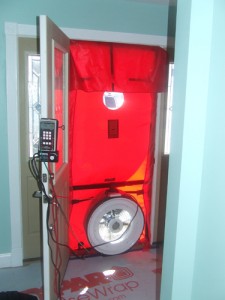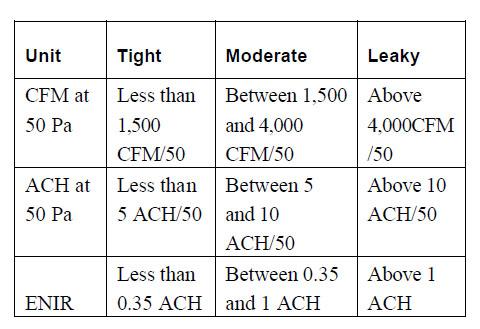Blower Door Test Results
Understanding Blower Door Test Results
 Last year we built an Energy Star Home for a customer and we used a blower door test to evaluate the houses air infiltration performance. Simply put a blower door is a diagnostic tool used to measure how much air infiltration (air leakage) occurs in a house. The blower door apparatus allows testers to apply a consistent and measurable pressure to the house so that houses can be compared accurately.
Last year we built an Energy Star Home for a customer and we used a blower door test to evaluate the houses air infiltration performance. Simply put a blower door is a diagnostic tool used to measure how much air infiltration (air leakage) occurs in a house. The blower door apparatus allows testers to apply a consistent and measurable pressure to the house so that houses can be compared accurately.
How A Blower Door Works
As you can see in the photo the blower door is installed in an exterior doorway. The equipment consists of a variable speed fan, fan speed controller, adjustable door frame for sealing the opening and a set of manometers to measure the pressure differential between the inside and outside of the house.
The tester then calibrates the equipment and sets it for a standard pressure. In our case the tester set the pressure to 50 pascals so that we could determine an ACH50 rating. The ACH50 rating was used as part of the Energy Star Rating that this particular home received. ACH refers to Air Changes Per Hour.
Once a pressure is set the diagnostic measuring equipment is able to measure the volume of air being pushed through the fan at the desired pressure. This is used to calculate the air exchanges per hour at a given pressure and hence our ACH50 value. The actual test only takes about 15 minutes once everything is set up.
Blower Door Test Results
Once you get the results of the blower door test it’s important to understand what they mean. There are numerous guidelines on the values and what they might mean for your home. This article will strictly focus on the ACH50 results that we obtained for this test house. Many states and building officials are also looking at the CFM/50 results as a way of determining if a house is too drafty or too tight.
According to The Pennsylvania Housing Research Center the following are basic guidelines for the ACH50 results:
- ACH50 less than 5.0 – Tight House
- ACH50 between 5.0 and 10.0 – Moderate House
- ACH50 above 10.0 – Leaky House
Below is a full table from their publication showing ACH50, CFM/50 and ENIR guidelines.
 Our Energy Star House Results
Our Energy Star House Results
The Energy Star House that we built last year received an ACH50 rating of 2.17 which correlates to a very tight house. In fact, the house is so tight that we installed programmable ventilation fans in order to ensure that the house received sufficient fresh air exchanges. This particular house wasn’t very large so the owners decided not to use a ERV system (Energy Recovery Ventilation) which might make sense on a larger home. Building a house too tight is something that is cause for concern but outside the scope of this article.
The bottom line is Blower Door Testing is an easy way to determine how well sealed a home is and also an effective tool at locating air leaks. In fact, we were able to identify some bad weatherstripping on one of the exterior doors during the test. Air leaks are easily located by the loud sound of air rushing through the openings.
Whether you’re building a new home or looking to improve the energy efficiency of an existing home, Blower Door Tests can certainly be beneficial in that process.














Todd: At what point do you blower-test new construction for air leakage? Ideally one would think that it would be before dry-walling, but then the ceiling to the attic/roof is not on at this point. Would it be just after insulating the walls and applying the ceiling leading to the roof/attic area? If so, I’m sure that this would not go over well with the drywall crew.
Actually it’s done at the very end. Most of the leaks that are found are around doors, sometimes windows, and penetrations. These are all things that can typically be corrected. In most cases, once you’ve done a few, you know what to do right sooner in the process the next time.
Is a blower door test required by state law if you meet the architects insulation specs which are approved by the town? And does the test requirement have to be specified in town regs or state regs? In this case I’m in CT..thanks!
Each state is different…you’d have to check with your local building code official.
Greetings Todd, I recently went through the whole energy incentive program with the town I live in, in RI. The insulation and air sealing was performed with great success. However, the company that performed the work didn’t supply me with a report stating the results or the actions they took to achieve those results. Is that something I should have received, or may be able to obtain? If that is the case, what exactly should I ask them for?
Every company is different, give them a call and ask if they have a report from the test.
I am a new York builder and was wondering if you know how to become a tester technician is there training or license you need to become a tester
Built a high performance house here in B.C. Canada, blower door test results came in @ .51 mid construction. Ehhhh.